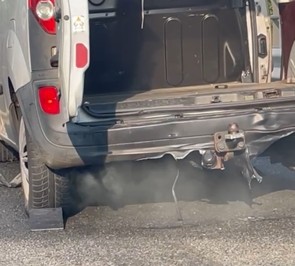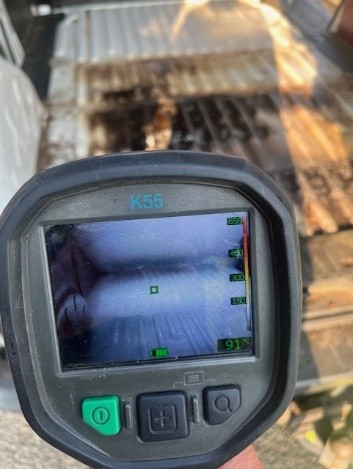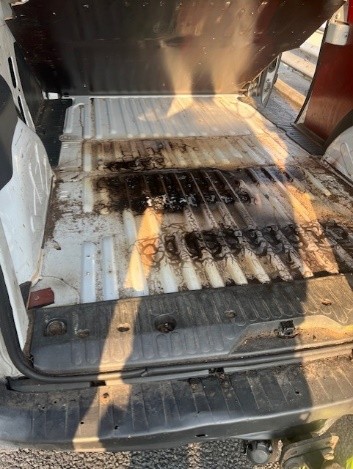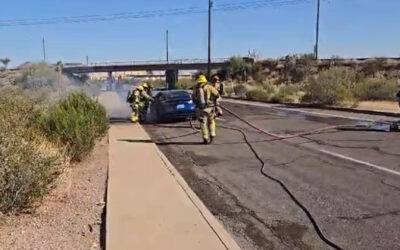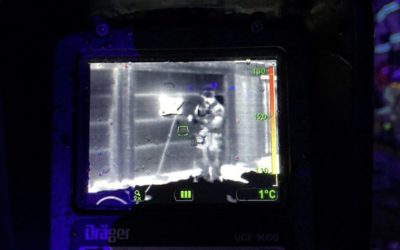Case Study: Effective Management of an EV Battery Fire on the A15, Netherlands
Photo and story credit: Joint Fire Department Rotterdam, Station Butaanweg.
On Thursday, July 18 (2024), an electric vehicle (EV) caught fire on the A15, near Merseyweg and Botlekweg. The incident occurred after the vehicle drove over an object, causing significant damage to its battery pack and initiating a thermal runaway.
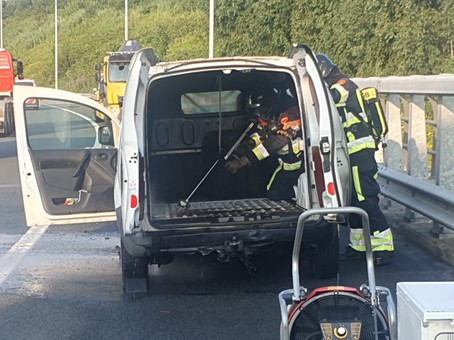
Rapid response but quickly depleting water supply
The initial response involved two fire engines, which quickly began to deplete their water reserves due to the intensity of the fire. A support vehicle was called for extra water, and the Officer on Duty suggested using Cobra to stop the propagation more efficiently. Additional units, including the Hazmat fire engine, were dispatched to assist.
Managing the fire and stopping propagation
Upon arrival of the hazmat team, a thorough reconnaissance of the vehicle revealed five hotspots within the battery pack, with varying temperatures and observed white smoke. The situation required careful planning to ensure firefighter safety and prevent further escalation.
The crew used a systematic approach to address the incident:
- Ventilation: They first deployed a fan to expel the smoke and vapours which were produced by the battery fire. The fan was strategically positioned with the wind to maximize effectiveness.
- Preparation for Cobra Deployment: Cobra was assembled and prepared for cooling the battery pack. The crew removed all cargo from the vehicle, to prevent further fire spread and to gain clear access to the battery pack.
- Cobra Application: Cobra was used on each of the five hotspots, progressively reducing the battery temperature. After five applications, the temperature dropped to a safe 30°C (86°F), rendering the vehicle stable for transport.
- Vehicle Recovery: Following the cooling, the vehicle was transferred to a recovery company using a ‘pre-alarmed immersion’ container.
Water efficiency and safety measures
Approximately 500 litres (132 US gal) of water were used during the entire incident, a significantly lower amount compared to conventional firefighting methods. Safety precautions included the effective use of a fan to manage smoke whilst keeping the vehicle’s windows and doors open to prevent internal smoke and vapour accumulation.
Preventing re-ignition and reducing damage
Cobra proved its effectiveness in this situation. Its penetrating and cooling capabilities efficiently controlled the propagation, minimizing fire damage and reducing the risk of re-ignition. Additionally, the water efficiency helped limit collateral damage, offering a significant advantage over traditional firefighting methods.
Minimising traffic impact through rapid response
This incident demonstrates the increasing importance of smarter firefighting, regarding tools and techniques when fighting modern challenges such as EV battery fires. Notably, the use of Cobra contributed to a swift outcome of the incident, minimizing the time required to shut down the A15. Prolonged road closures can lead to significant economic costs due to traffic disruptions, detours, and delays. In this case, the rapid cooling and management of the fire allowed traffic flow to resume more quickly compared to traditional methods, which might have required more extensive firefighting efforts and cleanup. Whilst traffic impact is always a concern in such situations, the effective handling of this incident demonstrates how cutting extinguishing techniques can not only improve safety but also reduce broader social and economic disruptions.
Key takeaways from the operation
- Rapid response and structured assessment ensured control.
- Cobra cooled the battery pack, stopping propagation and reducing re-ignition risk.
- Only 500 litres (132 US gal) of water were used.
- Ventilation helped manage smoke and vapours, improving firefighter safety.
- Quick resolution reduced traffic disruption and economic impact.
